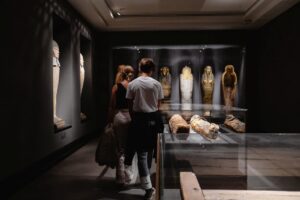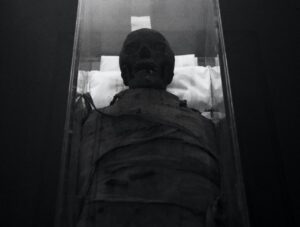The subject of dying has always held a certain allure for the human race. In certain societies, the dead are never allowed to be alone and instead remain in constant communication with the living.
For example, some people create ancestor cults as a way to honor their ancestors who have passed away. Some people have the opinion that the living can communicate with the dead via the use of mediums.
Although these types of engagement deal with the deceased in their ethereal forms, living people can also interact with the dead’s corporeal remains. The practice of preserving the bodies of the deceased is one of the most typical forms of this kind of connection.
Although the ancient Egyptian civilization is responsible for some of history’s most well-known mummies, this does not mean that it is the only culture to have ever created mummies.
Many tribes and time periods have produced mummies at various points throughout history. The Capuchin Catacombs of Palermo is a fascinating spot where visitors may still be seen gazing in awe at mummies ( Catacombe dei Cappuccini ).
The Capuchin Catacombs: Where Did They Come From?
The Capuchin Catacombs of Palermo can be found in the Italian region of Sicily. The Capuchin monks of Palermo made the discovery in the 16th century that the catacombs under their city had a natural preservative that helped mummify the bodies of the deceased.
The first person to be mummified was a member of their brotherhood named Brother Silvestro.
It would appear that he was a very saintly monk, and it would have been beneficial to have his body preserved so that it might have been used to lure pilgrims to Palermo.
In addition to luring pilgrims, it drew the interest of locals who yearned to be maintained in the same fashion as the travelers. Since that time, more than 8,000 people from all walks of life in Sicily have been mummified and buried in the catacombs.
The Catacombs’ Most Famous Resident, Sleeping Beauty
Rosalia Lombardo, who was just two years old when she died, is considered to be one of the most recent and maybe most renowned mummies.
After Rosalia passed away in 1920, her body was interred in the catacombs. Because her corpse was so well-preserved, people began to refer to her as “Sleeping Beauty.” This moniker came about because she appeared to have been dozing off in her glass coffin.
When a hand-written memoir of the embalmer, Alfredo Salafia, was found a few years ago, it disclosed the key to her remarkable condition of preservation, which had been kept a secret for so many years.
This narrative details the drugs that he administered to Rosalia by injecting them into her blood. Formalin, zinc salts, alcohol, salicylic acid, and glycerin were the compounds that were utilized here.
It has been hypothesized that the zinc salts were the primary factor in Rosalia’s incredible state of preservation, and this hypothesis has been supported by evidence.
It would appear that the monks were able to keep the catacombs maintained thanks to the contributions made by the relatives of those who had passed away.
Each new corpse was initially positioned within a provisional nook and then eventually relocated to a more permanent setting. The body stayed in its appropriate location for as long as the monks continued to get financial support.
Nevertheless, when the relatives stopped providing money, the body was put on a shelf so that it wouldn’t be disturbed until the payments were restored. It would appear that the monks were able to earn a living through the catacombs in a manner that was unexpectedly successful.
Examining the Lives of Mummified Children Through Research
The first in-depth investigation of the infant mummies found in the Capuchin Catacombs will get underway in December 2021 when a group of academics gets to work on the project.
The mission of the team, which will be led by Dr. Kirsty Squires, Associate Professor of Bioarchaeology at Staffordshire University, is to determine why the children were mummified and what their lives may have been like before they were preserved.
According to the university’s report, the researchers will analyze the remains of forty-one mummified youngsters from the 19th century using “non-invasive approaches” rather than “destructive treatments such as autopsy.”
The use of portable X-ray devices to take digital photographs (radiographs) of each kid, from head to toe, is included in these procedures that do not involve any sort of intrusive procedure.
The team expects that by analyzing the radiographs, they will be able to determine the age of the children, as well as their gender and whether or not they suffered from any pathological or traumatic lesions.
This information can also give insight into the surroundings and living situations of the children, which the researchers can compare to the lives of other children who were not mummified but lived in Palermo during the same period of time as the youngsters in question.
The research study will take place over the course of two years and will supply academics with drawings of juvenile mummies. This is because photography is not permitted in the Catacombs, and the subject matter is considered to be very sensitive.
According to the news release issued by the institution, the graphics will be created by the artist Eduardo Hernandez and distributed through “journal articles, lectures, a blog, and teaching packs translated into both Italian and English.”
Considering the Capuchin Catacombs in Palermo
The final thing that strikes me as ironic about the catacombs is that the Christian concepts of life being a passing phase and the idea of equality before God have been tossed out the window. This is something that strikes me as ironic.
It would appear that many of the persons who were buried in the catacombs had written wills in which they specified the type of clothing they wanted to be buried in, and some of them even requested that their clothing be changed periodically throughout the course of their afterlife.
It would appear that these individuals were unable to let go of their fleeting earthly existence even after death, as evidenced by the fact that they continue to cling to it. In addition to this, there is a distinct separation of socioeconomic classes that can be seen throughout the catacombs. 
There are different sections for priests, monks, men, women, virgins, children, and professionals. It would appear that those who have passed on maintain whatever social standing they had in life.
As a result, it would appear that the catacombs are a reflection of the vanity of individuals who were buried there, as well as their inability to let go of their earthly lives.
Maybe we should use this as an opportunity to think about our own lives. From observing the deceased buried in the catacombs, one can come to the conclusion that life is fleeting and that one’s earthly possessions are meaningless after death.
It is possible that by doing so, we may become aware of the vital things in life and come to respect each minute that we have.
Mysterious Child Mummies Discovered in Sicily Catacombs: A Comprehensive Study
The discovery of dozens of mummified children buried in a catacomb in Palermo, Sicily has left scientists puzzled. These mummified remains have become a macabre tourist attraction, and the largest collection of mummified remains in Europe.
A team of scientists from Staffordshire University in the UK is now leading the first comprehensive study of the remains to understand their lives, health, and development.
The Capuchin Catacombs
The Capuchin Catacombs in Palermo, northern Sicily, has become a macabre tourist attraction over the years. The catacombs contain the largest collection of mummified remains in Europe, comprising at least 1,284 bodies.
Within the catacombs, a designated room for children contains 41 mummified remains. The mummies are fully clothed, with some placed in cradles and chairs, while others are upright with sticks used to hold them in position. The significance of these artifacts is still unknown.
Understanding the Lives of the Mummies
The team from Staffordshire University, led by Kirsty Squires, aims to analyze the biological data and cultural artifacts of these remains to understand the lives, health, and development of these individuals. The mummies were buried between 1787-1880, and it is known that they would have come from middle-class families.
The mummification rite was reserved for wealthier individuals like the nobility, the middle class, and the clergy. However, little else is known about these children, and the researchers are keen to learn why they were mummified and not buried like other individuals.
The Study Process
The team is using non-invasive methods to study the mummified remains, and the first step is X-ray imaging. The use of X-ray imaging is a non-invasive method that doesn’t throw up the same ethical considerations as invasive investigations on human remains.
Kirsty Squires stated that they are using a portable X-ray machine to take radiographs to estimate the age of individuals based on their dental eruption and development and fusion of the bones. They will also be looking for signs of disease.
The researchers will use the radiographs, which are 574 in total, or 14 per mummy, to fill in a biological profile of the children and work out whether mummification was only performed on those of a certain age or sex. Dentists and dental experts also analysed their teeth to understand their history.
The radiographs will also be used to detect the presence of developmental defects, stress indicators, and pathological lesions, which aims to gain insight into the health and lifestyle of children in life.
Cultural Artifacts
Apart from the biological data, the researchers will also analyze the cultural artifacts found within the catacombs.
The mummies were fully clothed, and some were placed in cradles and chairs, while others were upright with sticks used to hold them in position. The researchers will examine the significance of why these artifacts were used.
Results of the Study
The study of these mummified remains is a groundbreaking discovery and will provide insight into the lives, health, and development of these individuals. The use of non-invasive methods to study the remains is a significant step in the field of bioarchaeology.
It will take months for the findings to be published, and we eagerly await the results to unlock the mysteries behind these mummified children buried in the catacombs of Palermo, Sicily.
Conclusion
The Catacombs of Palermo is a unique and fascinating site that provides insight into the history, culture, and social practices of Sicily. The preservation of the mummified remains in the catacombs has allowed researchers to study and understand the lives of individuals from the past.
The ongoing research by the team of scientists led by Kirsty Squires will shed further light on the mystery of the child mummies and why they were buried in such a manner.
Despite the macabre nature of the catacombs, it remains a popular tourist attraction, attracting visitors from around the world who are intrigued by the living meet the dead.




